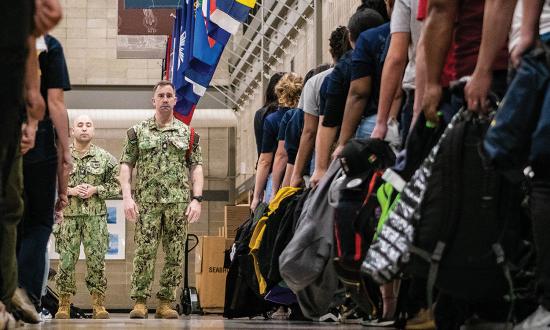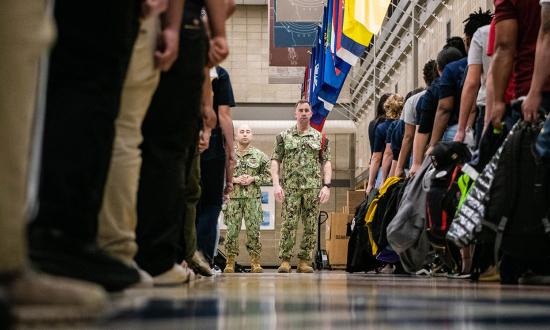The U.S. military is in the midst of the worst recruiting crisis since 1973 with no end in sight, and the Navy has once again failed to reach its recruiting goals. While Vietnam was forefront in the minds of America’s youth in the 1970s, today’s recruiting crisis has seen fallout from the wars in Iraq and Afghanistan, alongside other societal factors. While there is no one-size-fits-all cure for the current manpower problems, the Navy must nonetheless forge ahead and align recruitment and retention standards with the real workforce needs. The current system used to determine individual eligibility for service is not aligned with the Navy’s needs. As jobs have become more technical and more specialized, the tools used to fill them remain blunt instruments and speak to a larger issue around the lack of tailored requirements and career paths within an increasingly specialized military.
Physical Standards
First, the Navy must acknowledge that not all service members are serving in physically demanding jobs. The world has changed, and with it the type of work; there is a premium on the intellect and creativity in sailors. A master-at-arms must be in better physical shape than a yeoman; a damage controlmen must be more fit than a cyber warfare technician. The misguided application of physical fitness as a universal discrimination tool alienates a large pool of individuals with valuable skills. Currently, the Navy has a one-size-fits-all model with a minimum standard of fitness set too low to be adequate for some jobs while remaining too high for others. The Navy needs a targeted approach, matching the job to the requirements.
The Navy has been slow to recognize the problem. The Navy’s Physical Readiness Program changed in 2017 to halt separations based on physical fitness assessment (PFA) failures alone, and instituted new policies to enhance retention. In February 2023, the Navy conducted a one-time reset of all PFA failures. While designed to level the playing field from aftereffects of COVID-19 responses, it also was meant to boost retention. These initiatives certainly have merit but are essentially blunt tools. The ultimate intent of the Physical Readiness Program to maintain a minimum level of fitness to support worldwide deployment implies every sailor must be deployable worldwide. However, not every sailor needs to be.
The Navy should reclassify occupations based on the actual requirements of the job to enable recruiting the appropriate people to fill those positions; specifically, an unnecessary focus on physical fitness for jobs that do not require someone to do more than sit at a desk. The shifts in the civilian workforce from manual to intellectual labor over the past century have been mirrored in the armed services. That the Navy has maintained the same paradigm for determining eligibility to serve has led to missed opportunities to tap a pool of individuals with much to contribute to the nation’s security.
In addition, individuals with health conditions unsuitable for forward-deployed or shipboard life could be better employed in specific jobs or locations that are now unavailable to them. Whether based on physical fitness or health conditions, employing a targeted approach based on the requirements of a rate would enhance capability, boost retention, and provide a larger pool of eligible recruits.
The Changing Character of Work
Over the past couple decades, approximately one third of the new jobs created in the United States were brand new types of jobs, especially those in information technology. The military has not been insulated from the monumental shift in the labor force. Creep in job responsibilities and reactive policy initiatives mean that network administrator was a collateral duty in some places in the Navy as recently as 10 years ago. The cyber warfare technician rating was only created in 2023. While it is good that there have been changes to reflect the evolving character of work in the armed forces, recruiting and retention requirements have not evolved in turn.
A reimagining of how to manage IT professionals would not just aid the Navy, it would provide significant benefit to sailors. A 2017 McKinsey survey suggested 40 percent of employers see lack of skill as an entry-level barrier and 60 percent see new graduates as unprepared for their jobs both technically and in soft skills like teamwork and communication. The Navy is uniquely positioned to take advantage of this experience gap, as the service provides a structure designed to develop well-rounded individuals and build technical expertise. This puts sailors in an ideal position whether they decide to reenlist or not. With expanded eligibility for enlistees, more individuals will be able to be trained, contribute to the Navy’s mission, and, ultimately, participate meaningfully in the civilian workforce.
Finally, consider cost savings. If individuals were trained for more technical jobs and kept in those positions for a longer period than the traditional sea/shore rotation, the Navy could provide greater geographic stability, better and more involved technical training, and build resiliency all while potentially reducing cost by fulfilling requirements of tasks currently contracted out. The Navy could take ownership over the maintenance of the information technology infrastructure by training and retaining more talent within the force, providing the double benefits of cost savings while improving the level of service.
Looking Forward
While some may oppose changes to physical fitness requirements by claiming the Navy is lowering its standards, this is simply aligning the standards with the current needs. Civilian firefighters have physical requirements for fitness while civilian network administrators do not. The Navy should not impose a self-defeating set of requirements. If Navy wants to address retention and recruit the best talent available, candidates should not be overlooked based on their body composition—especially if their specialty makes it irrelevant. Moreover, including a broader group of society will help to increase diversity and provide a mutually beneficial opportunity to influence behaviors that could improve the individual’s long-term health.
Without a change to the Navy’s force structure and personnel standards, an all-volunteer force will soon become impossible to maintain. Missed recruiting goals lead to understaffed ships, overworked sailors, and involuntary extensions—all culminating in greater difficulty retaining existing sailors. Without a holistic approach that aligns recruitment and retention standards to the real workforce needs, the Navy will miss the mark by continuing to try to put a round peg through a square hole. A specialized set of physical fitness requirements tailored to specific jobs would increase the Navy’s ability to meet its recruiting goals. It is imperative for the Navy to fix its workforce misalignments so it can maintain its competitive edge.






